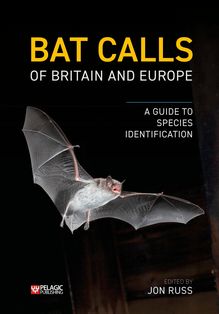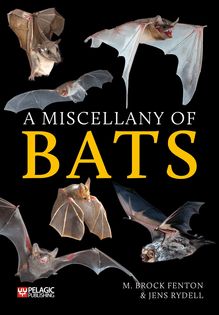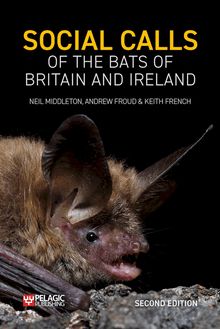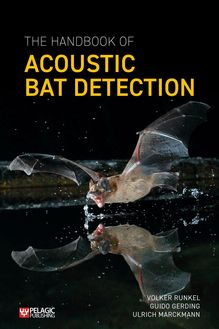-
 Univers
Univers
-
 Ebooks
Ebooks
-
 Livres audio
Livres audio
-
 Presse
Presse
-
 Podcasts
Podcasts
-
 BD
BD
-
 Documents
Documents
-
- Cours
- Révisions
- Ressources pédagogiques
- Sciences de l’éducation
- Manuels scolaires
- Langues
- Travaux de classe
- Annales de BEP
- Etudes supérieures
- Maternelle et primaire
- Fiches de lecture
- Orientation scolaire
- Méthodologie
- Corrigés de devoir
- Annales d’examens et concours
- Annales du bac
- Annales du brevet
- Rapports de stage
La lecture à portée de main
Vous pourrez modifier la taille du texte de cet ouvrage
Découvre YouScribe en t'inscrivant gratuitement
Je m'inscrisDécouvre YouScribe en t'inscrivant gratuitement
Je m'inscrisEn savoir plus
Vous pourrez modifier la taille du texte de cet ouvrage
En savoir plus

Description
This guide provides descriptions of when the bat species resident in Britain and Ireland use natural and human-made rock habitats, how they use them, and the environments each species occupies therein. For the first time it brings together findings from historical scientific investigations, useful photographic accounts and open-access biological records, along with a rich seam of new data – all in a practical and user-friendly structure. The book encompasses:
~ Descriptions of the features that a climber, caver or professional ecologist might encounter on and in rock habitats where bats roost.
~ Recording criteria for both the physical and environmental attributes of different features and situations.
~ Identification of suitability thresholds against which the recorded information can be compared to assess the likelihood that a specific feature might be exploited by a particular bat species.
~ Suggestions for how to avoid mistakes and difficulties when performing a survey.
The intention is that using this book will help generate standardised biological records which can feed into the fully accessible online database at www.batrockhabitatkey.co.uk. These data will be analysed to search for patterns that can increase the confidence in the suitability thresholds and help build roost features that deliver the environment each species really needs. As well as offering many new insights, this book allows the reader to participate in cutting-edge research.
Sujets
Informations
| Publié par | Pelagic Publishing |
| Date de parution | 23 novembre 2021 |
| Nombre de lectures | 0 |
| EAN13 | 9781784272623 |
| Langue | English |
| Poids de l'ouvrage | 31 Mo |
Informations légales : prix de location à la page 0,2800€. Cette information est donnée uniquement à titre indicatif conformément à la législation en vigueur.
Extrait
Bat Roosts in Rock
Frontispiece Anyone can find horseshoe bats in rock; it takes real determination and skill to find a whiskered bat Myotis mystacinus behind a sandstone flake, and retrieve a dropping to get the identification confirmed by DNA analysis. © Rob Bell
Bat Roosts in Rock
A Guide to Identification and Assessment for Climbers, Cavers & Ecology Professionals
Bat Rock Habitat Key
Pelagic Publishing | www.pelagicpublishing.com
First published in 2021 by Pelagic Publishing PO Box 874 Exeter EX3 9BR, UK
www.pelagicpublishing.com
Bat Roosts in Rock: A Guide to Identification and Assessment for Climbers, Cavers & Ecology Professionals
© Henry Andrews 2021
The moral rights of the author have been asserted.
All rights reserved. Apart from short excerpts for use in research or for reviews, no part of this document may be printed or reproduced, stored in a retrieval system, or transmitted in any form or by any means, electronic, mechanical, photocopying, recording, now known or hereafter invented or otherwise without prior permission from the publisher.
Unless otherwise stated in the caption, all photographs are © Henry Andrews.
British Library Cataloguing in Publication Data A catalogue record for this book is available from the British Library
https://doi.org/10.53061/RKRW8270
ISBN 978-1-78427-261-6 Paperback ISBN 978-1-78427-262-3 ePub ISBN 978-1-78427-263-0 PDF
Cover images:
Top (main) image: A common pipistrelle Pipistrellus pipistrellus recorded behind a gritstone flake by Rob Bell and his comrades from South Yorkshire Bat Group. © Rob Bell
Bottom left: A Natterer’s bat Myotis nattereri roosting high in a limestone alicorn. © Henry Andrews
Bottom middle: Sam Dyer going the extra mile to record a Welsh serotine Eptesicus serotinus roost behind a limestone flake 20 m up a worked-out quarry face. © Sam Dyer
Bottom right: A Welsh brown long-eared bat Plecotus auritus recorded in a sandstone crack by Hal Starkie and his roost-finding posse. © Hal Starkie
Contents
Preface
Citing, credits and acknowledgements
1 Rationale
2 An introduction to rock
3 Rock faces: characterising and recording the landforms and the Potential Roost Features they may hold
4 Loose rock: characterising and recording the landforms and the Potential Roost Features they may hold
5 Subterranean rock: characterising and recording the landforms and the Potential Roost Features they may hold
6 Advice for anyone proposing to survey a rock landform or monitor an artificial landform to deliver a new roost for a specific bat species
Appendix A: Solution caves, sea caves, mines and railway tunnels that are notified as Sites of Special Scientific Interest (SSSI) for bats
Appendix B: Eighty-five popular climbing crags, the counties they occur in and the rocks they are made of
Notes
References
Index
Preface
Much of the information that has historically been published about bats in rock in the British Isles was not formatted with practical application in mind. Regardless, in the early 2020s our basic knowledge of exactly how bats exploit rock remains patchy.
In the case of rock faces, historically we have had: Sam Dyer’s work with serotines Eptesicus serotinus ; the results of a study by Mike Shewring; two photographic accounts of individual barbastelle Barbastella barbastellus and brown long-eared bat Plecotus auritus from Jean Matthews and Nathalie Cossa respectively, but aside from a lot of smoke and mirrors, that really was it.
There has been Scandinavian work published on scree, but in the British Isles there have been just vague musings and little else.
The accounts of subterranean roosts that were published in the British Isles and Europe in the 1960s and 1970s are comprehensive when collated, and both minutely detailed and jaw-dropping in their scope. But these accounts appear not to have been widely read. Meanwhile, some accounts that have been widely cited might have unintentionally been misinterpreted.
Even now, some accounts that might improve our understanding remain out of circulation, and could not therefore be collated into this book. In particular, we would like to see:
» Baagoe, H., Degn, H. & Nielsen, P. 1988. Departure dynamics of Myotis daubentonii (Chiroptera) leaving a large hibernaculum. Vidensk. Meddr. Dansk naturh. Foren . 147: 7–24.
» Jurczyszyn, M. 1998. The dynamics of Myotis nattereri and M. daubentonii (Chiroptera) observed during hibernation season as an artefact in some type of hibernacula. Myotis 36: 86–91.
In combination, the historical British accounts, together with both historical and more modern Scandinavian and European accounts, offer the potential for the definition of a framework for data collection. This framework could be used to identify the environmental niche of our resident species, and that data might thereon be used to: a) identify existing potentially important rock habitats; b) inform enhancement projects; c) inform designs for entirely new ‘artificial’ habitats in situations where they must be built ‘from scratch’; and, d) define environmental trigger thresholds for monitoring programmes that can be adopted as a definition of success.
In 2021 we have the technological gadgetry to gather the data needed to understand why different bat species occupy different sites in different numbers at different times. Once collected this data might be collated on one database and made accessible to everyone (see www.batrockhabitatkey.co.uk ).
We finally have the means to communicate this information across the length and breadth of the British Isles and the wider network of ecologists around the world in Technicolor detail, and has long since been identified:
Full disclosure of data is an elementary precaution against both honest mistakes and charlatans.
Peters, R. 1991. A Critique for Ecology . Cambridge University Press.
It is likely that the lion’s share of the work will be done by amateur naturalists, but nevertheless it will ensure professional ecologists have an evidence base to draw from.
Ultimately, it is hoped that the book will benefit the bats.
Citing, credits and acknowledgements
Citing
Where reference is made to any part of the content of this book, please cite as ‘BRHK 2021’ giving the full reference as:
» BRHK 2021. Bat Roosts in Rock – A Guide to Identification and Assessment for Climbers, Cavers & Ecology Professionals . Pelagic Publishing, Exeter.
Credits
Text
Chapter credits are as follows:
» Chapter 1 – Henry Andrews
» Chapter 2 – Henry Andrews & Steven Hopkins
» Chapter 3 – Henry Andrews, Robert Bell, James McGill & Hal Starkie
» Chapter 4 – Henry Andrews & James McGill
» Chapter 5 – Henry Andrews
» Chapter 6 – Henry Andrews
Henry Andrews is the founder of both the Bat Tree Habitat Key and Bat Rock Habitat Key projects. He has a particular interest in the use of structure-based predictive frameworks and data-driven analysis in the definition of hypotheses against which to compare the results of surveys.
Steven Hopkins is an engineering geologist with 20 years of experience and has worked in the quarrying industry since 2006. He is chartered with the Geological Society of London and is a Fellow of the Institute of Quarrying. His interest lies in how we use and engineer the natural geology for the benefit of society.
Robert Bell is a long-term member of South Yorkshire Bat Group with a keen interest in bat conservation. He is a partner in Middleton Bell Ecology, a small ecological consultancy based in Barnsley.
Dr James McGill is an entomologist, ornithologist, and botanist.
Hal Starkie is a bat ecologist who undertakes multiple research projects within the south Wales region, including studies of woodland Myotis bats, Nathusius pipistrelles, bat roosts within rock faces and swarming bats. He is involved in many aspects of bat work, and acts as records officer for Cardiff Bat Group, as well as having been a registered bat carer since 2014. Hal has also worked with bats across the world including work in Europe and Africa.
Photographs
BRHK is grateful to the naturalists who have provided the individual photographic accounts we have used as illustrations, as follows:
Chapter 3
Jean Matthews for the photographs of the barbastelle Barbastella barbastellus roost in a break; Hal Starkie for photographs of the serotine Eptesicus serotinus roosts in a crack and bidoigt, the Daubenton’s bat Myotis daubentonii roost in a break, and the brown long-eared bat Plecotus auritus roosts in a crack and behind a flake; Sam Dyer for the photographs of the serotine Eptesicus serotinus roost behind a flake; Robert Bell for photographs of the whiskered bat Myotis mystacinus roosts in a crack and behind a flake, the Natterer’s bat Myotis nattereri roosts in a crack and behind a flake, the common pipistrelle Pipistrellus pipistrellus roosts in a break and behind a flake, and the soprano pipistrelle Pipistrellus pygmaeus roost in a crack; and, Ian Wright for the photographs of the common pipistrelle roost in a crack.
Chapter 5
Stuart Spray Wildlife for photographs of the complexity and scale of mines, the sloping silt-covered shelf which gives way to a deep and cold sump, the subterranean lake in a mine system, the mining hall, and the simple and complex caverns; Paul Bowyer for the photograph of tissue Triphosa dubitata ; Colin Morris for the photographs of whiskered bats roosting in pleats; and, Rich Flight for the images of a vertical pothole entrance, and various bats roosting in pleats, cracks, breaks, flowstone, and alicorns.
Acknowledgements
Henry Andrews – My thanks to George Bemment for showing me Oak Cave and attempting to inspire me to take an interest in cave-roosting ecology over a decade ago; see, I was listening.
Thanks also: to Chris Barrington for thinking to send me Coward’s 1907 paper, which led to a load of other interesting stuff; to Geoff Billington for supplying coastal cave data and without
-
 Univers
Univers
-
 Ebooks
Ebooks
-
 Livres audio
Livres audio
-
 Presse
Presse
-
 Podcasts
Podcasts
-
 BD
BD
-
 Documents
Documents
-
Jeunesse
-
Littérature
-
Ressources professionnelles
-
Santé et bien-être
-
Savoirs
-
Education
-
Loisirs et hobbies
-
Art, musique et cinéma
-
Actualité et débat de société
-
Jeunesse
-
Littérature
-
Ressources professionnelles
-
Santé et bien-être
-
Savoirs
-
Education
-
Loisirs et hobbies
-
Art, musique et cinéma
-
Actualité et débat de société
-
Actualités
-
Lifestyle
-
Presse jeunesse
-
Presse professionnelle
-
Pratique
-
Presse sportive
-
Presse internationale
-
Culture & Médias
-
Action et Aventures
-
Science-fiction et Fantasy
-
Société
-
Jeunesse
-
Littérature
-
Ressources professionnelles
-
Santé et bien-être
-
Savoirs
-
Education
-
Loisirs et hobbies
-
Art, musique et cinéma
-
Actualité et débat de société
- Cours
- Révisions
- Ressources pédagogiques
- Sciences de l’éducation
- Manuels scolaires
- Langues
- Travaux de classe
- Annales de BEP
- Etudes supérieures
- Maternelle et primaire
- Fiches de lecture
- Orientation scolaire
- Méthodologie
- Corrigés de devoir
- Annales d’examens et concours
- Annales du bac
- Annales du brevet
- Rapports de stage










